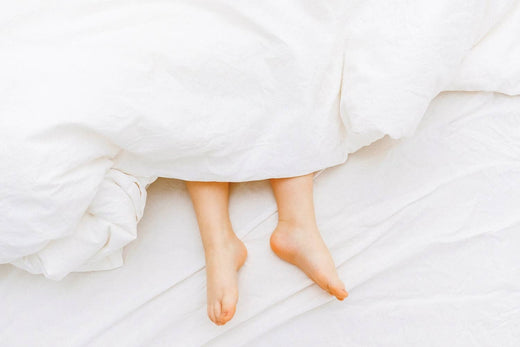
What Are the Different Types of Bed Sheets?
|
|
Time to read 4 min
|
|
Time to read 4 min
When it comes to getting a good night’s sleep, there is nothing more important than having a good set of sheets to curl up in.
Not only do sheets play a role in making your bed comfortable and warm, but choosing the right material is also important for your skin. So, what are the different types of bed sheets? and which one is the best for you?
Table of content
Sheets come in all different shapes, sizes, materials, weaves, and each type comes with its own unique properties. Choosing the correct set comes down to considering how you sleep, the type of bed you have, and what you find most comfortable. While it is easy to get caught up in the various weave types, thread counts and staple lengths, what's most important is choosing a material that is comfortable for you, fits in your budget, and is sourced as sustainably as possible.
First up in our bed sheet material guide is cotton. Cotton sheets are the most common kinds of sheets on the market. Cotton is highly versatile and comes in many qualities, product types and styles. However, not all cotton sheets are created equal. So, what are the different types of bed sheets made from cotton?
Egyptian cotton sheets are typically regarded as the best quality with a smooth texture and high durability. The reason for this is its long and soft fibres woven into sheets with a typical thread count of 400. While Egyptian cotton is known for its comfort and durability, it is also the most expensive cotton sheet.
In contrast to smooth Egyptian sheets, many people enjoy the warm and comforting texture of flannel sheets. The cotton in this material has been shredded and shaved to create a thicker, fuzzier feel. Flannel sheets are favoured in cold weather.
Linen is often an interchangeable term to describe bedding material, like Manchester. However, linen is a material made from flax and is very popular due to its light and airy feel. Whether you opt for a 100% linen sheet or one blended with cotton, linen generally provides durable bedding that allows plenty of airflow.
Bamboo is an environmentally friendly material that grows quickly and is commonly used in other products such as underwear and socks. Bamboo sheets are woven into a fine yarn that is smooth, soft, and breathable. The hypo-allergenic material is also ideal for people with sensitive skin. Bamboo sheets are increasing in popular due their environmentally friendly manufacturing processes, durability, silky-smooth texture and ability to keep you warm in winter and cool in summer.
At Linenly, we provide Australia’s leading collection of 100% organic Linenlybamboo bed sheet sets, blankets, pillowcases, and more.
Silk is a material made from silkworms and associated with luxury kinds of bedding. These sheets are cool and soft, although some people find them too smooth and slippery to sleep in. Like bamboo bedding, they are hypoallergenic and favoured by people who suffer from allergies. Due to the delicate manufacturing process, silk sheets are on the more expensive side in this bed sheet material guide.
While silk sheets are glossy, soft, and luxurious, polyester sheets are a budget option made of woven materials that can be scratchy and stiff. While polyester can be uncomfortable and sweaty to sleep with, there are various blends with cotton that produce differing results.
Microfibre sheets are a variation of polyester sheets. The polyester is woven extremely fine, producing sheets that are easy to clean and great in cold weather. While this makes it great for kids or for those who have pets, it may be less breathable and sweaty for some.
Satin sheets are made from synthetic fibres that can be woven or knitted. Woven sheets are softer, while knitted can be slightly rougher and heavier. These sheets have a silky, glossy finish that feels like silk but is more affordable.
Now that we’ve covered materials, what are the types of sheets that people generally sleep with?
Fitted sheets go over the mattress or mattress protector. These sheets are fitted with elastic corners that grip around the edge of the mattress. It is essential to buy the correct size for your bed, as otherwise, you will not be able to fit your fitted sheet over your mattress.
Flat sheets are placed on top of the fitted sheet. While you sleep on top of the fitted sheet, you sleep under the flat sheet. Some people find these unnecessary; however, they stop you from sweating into your blankets and are much easier to clean.
When choosing bed sheets, it is essential to consider more than just thread count. Consider how you sleep, what materials are suitable for your skin and if you’re a hot or cold sleeper. Warm sleepers may prefer a lighter breathable material such as bamboo that doesn’t trap heat and make them sweat, while cold sleepers might opt for a heavier sheet such as a flannel. With little ones, consider the durability and how certain materials deal with stains. Depending on where you live, it might also be essential to have different sheets as the seasons change.
For more insights on selecting the best sheets, you can explore the best quality sheets for your needs.
If you are looking for 100% organic sheets that are durable, soft, and comfortable all year round, look no further than Linely Bamboo Sheets. We may be biased; but we genuinely believe that the best bed sheets on the market are those that are made from bamboo.
Our sheets ensure that everyone, including our environment, benefits from high-quality bedding options for a great night’s sleep. For more information, please browse our range of bamboo bedding or contact us today.

